1993 CHEVROLET S10 service
[x] Cancel search: servicePage 295 of 356

Downloaded from www.Manualslib.com manuals search engine If you ever replace your tires with those not having a TPC Spec number,
make sure they are the same size, load range, speed rating an\
d construction
type (bias, bias-belted or radial) as your original tires.
Mixing tires
could cause you to lose control while driving. If you mix
tires of different types (like radial and bias-belted tires) the vehicl\
e
may nlot handle properly, an'd you could have a cras'h. Be sure to
use the same size 'and type tires on all four wheels.
It's all right to drive with your compact spare (if you have one). It
I was developed for use on your vehicle.
Uniform Tire Quality Grading
The following information relates to the system developed by th\
e United
States National Highway Traffic Safety Administration which grade\
s tires by
treadwear, traction and temperature performance. (This applies o\
nly to
vehicles
sold in the United States.)
Treadwear
The treadwear grade is a comparative rating based on the wear rate of the
tire when tested under controlled conditions on a specified government test
course. For example, a tire graded
150 would wear one and a half (1 -1/2)
times as well on the government course as a tire graded 100. The relative
performance of tires depends upon the actual conditions of their use,
however, and may depart significantly from the norm due to var\
iations in
driving habits, service practices and differences in road charac\
teristics and
climate.
Traction-A, B, C
The traction grades, from highest to lowest are: A, B, and C. They represent
the tire's ability to stop on wet pavement as measured under controlled
conditions on specified government test surfaces of asphalt and concrete.
A
tire marked C may have poor traction performance.
Warning: The traction grade assigned to this tire is based on braking
(straight-ahead) traction tests and does not include cornering \
(turning) traction.
Temperature-A, B, C
The temperature grades are A (the highest), B, and C, representing the tire's
resistance
to the generation of heat and its ability to dissipate heat when
tested under controlled conditions on a specified indoor laboratory test wheel,
Sustained high temperature can cause the material of the tire
to degenerate
and reduce tire life, and excessive temperature can lead to sudden tire
6-47
Page 296 of 356

Downloaded from www.Manualslib.com manuals search engine Service & Appearance Care
failure. The grade C corresponds to a level of performance which all
passenger car tires must meet under the Federal Motor Vehicle \
Safety
Standard
No. 109. Grades B and A represent higher levels of performance on
the laboratory test wheel than the minimum required by law.
Warning: The temperature grade for this tire is established for\
a tire that is
properly inflated and not overloaded. Excessive speed, underinfla\
tion, or
excessive loading, either separately or in combination, can cause heat buildup
and possible tire failure.
These grades are molded on the sidewalls of passenger car tire\
s.
While the tires available as standard or optional equipment on \
General Motors
vehicles may vary with respect
to these grades, all such tires meet General
Motors performance standards and have been approved for use on \
General
Motors vehicles.
All passenger type (P Metric) tires must conform to Federal
safety requirements in addition
to these grades.
Wheel Alignment and Tire Balance
The wheels on your vehicle were aligned and balanced carefully \
ar IT.-
factory to give you the longest tire life and best overall performance.
In most cases, you will not need
to have your wheels aligned again.
However,
if you notice unusual tire wear or your vehicle pulling one way \
or
the other, the alignment may need
to be reset. If you notice your vehicle
vibrating when driving on a smooth road, your wheels may need
to be
rebalanced.
Wheel Replacement
Replace any wheel that is bent, cracked or badly rusted. If wheel nuts keep
coming loose, the wheel, wheel bolts, and wheel nuts should be\
replaced. If
the wheel leaks air out, replace it (except some aluminum wheels, which can
sometimes be repaired). See your GM dealer
if any of these conditions exist.
Your dealer will know the kind of wheel you need.
Each new wheel should have the same load carrying capacity, di\
ameter,
width, offset, and be mounted the same way as the one
it replaces.
If you need to replace any of your wheels, wheel bolts, or wheel nuts,
replace them only with
new GM original equipment parts. This way, you will
be sure you have the right wheel, wheel bolts, and wheel nuts\
for your
vehicle.
6-48
I
Page 298 of 356
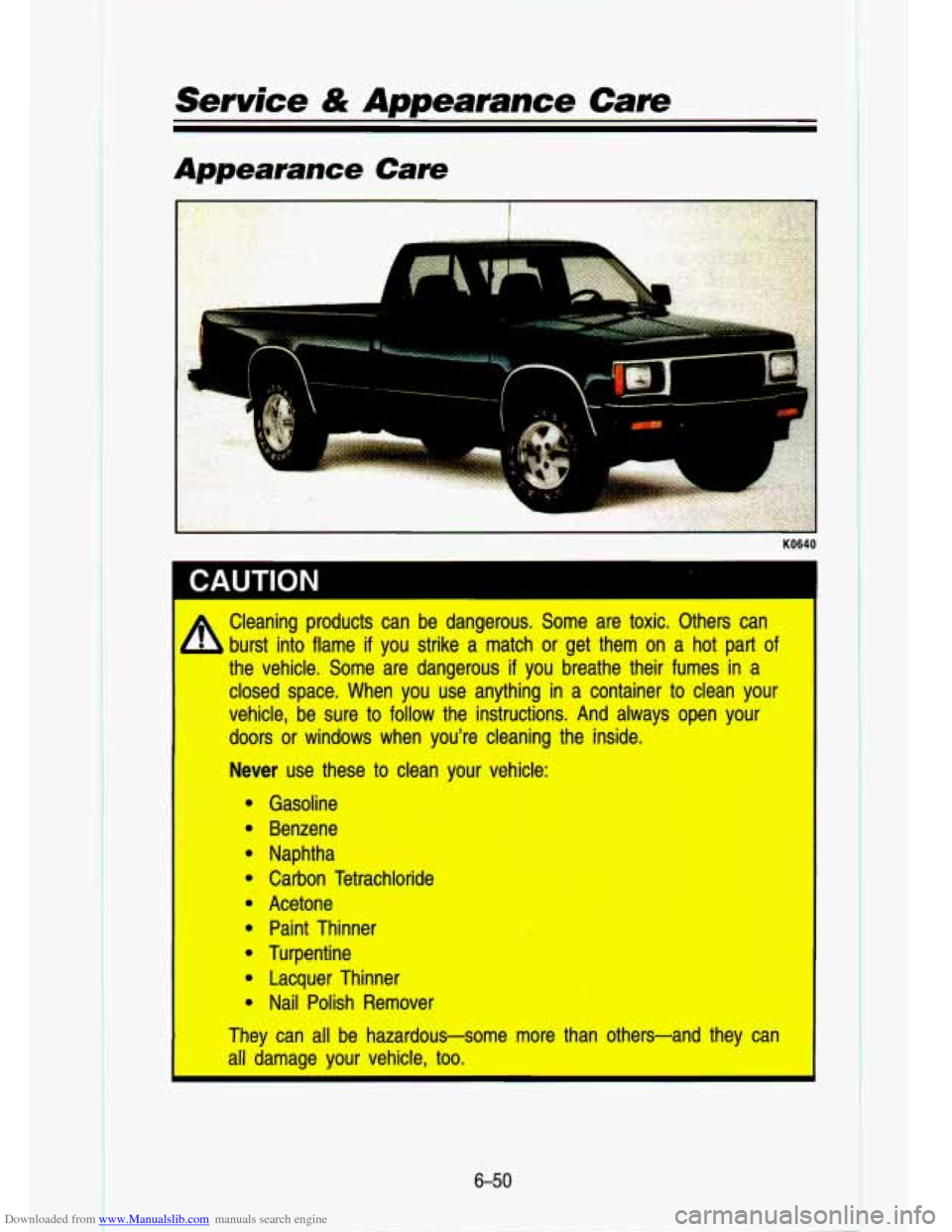
Downloaded from www.Manualslib.com manuals search engine Service & Appearance Care
Appearance Care
-
KO640
CAI lTlnN
I.
Cleaning products can be dangerous. Some are toxic. Others can \
burst into flame
if you strike a match or get them on a hot part of
the vehicle. Some are dangerous if you breathe their fumes in a
closed space. When you use anything in a container to clean your
vehicle, be sure to follow the instructions. And always open your
doors or windows when you’re cleaning the inside.
Never use these to clean your vehicle:
Gasoline Benzene
Naphtha
Carbon Tetrachloride
Acetone Paint Thinner
Turpentine Lacquer Thinner
Nail Polish Remover
They can all be hazardous-some more than others-and they can
all damage your vehicle, too.
6-50
Page 300 of 356

Downloaded from www.Manualslib.com manuals search engine Service & Appearance
Rinse the section with a clean, wet sponge.
Wipe off what’s left with a slightly damp paper towel or c\
loth.
Then dry it immediately with an air hose, a hair dryer or a heat lamp.
Wipe wlrh a clean cloth.
Using Solvent-Type Cleaner on Fabric
First, see if you have to use solvent-type cleaner at all. Some spots and
stains will clean off better with just water and mild soap.
If you need to use it, then:
Gently scrape excess soil from the trim material with a clean,\
dull knife
or scraper. Use very little cleaner, light pressure and clean cloths
(preferably cheesecloth). Cleaning should start at the outside \
of the stain,
“feathering” toward the center. Keep changing to a clean section of the
cloth.
When you clean a stain from fabric, immediately dry the area \
with an air hose, hair dryer, or heat lamp to help prevent a cleaning ring. (See
.
previous NOTICE.)
Special Cleaning Problems
Greasy or Oily Stains: Like grease, oil, butter, margarine, shoe polish, coffee
with cream, chewing gum, cosmetic creams, vegetable oils, wax c\
rayon, tar and asphalt.
Carefully scrape off excess stain.
Then follow the solvent-type instructions above.
Shoe polish, wax crayons, tar and asphalt will stain if left on a vehicle
seat fabric. They should be removed as soon as possible. Be c\
areful, because the cleaner will dissolve them and may cause them
to bleed.
Non-Greasy Stains: Like catsup, coffee (black), egg, fruit, fr\
uit juice, milk,
soft drinks, wine, vomit, urine and blood.
Carefully scrape off excess stain, then sponge the place with cool water.
If a stain remains, follow the foam-type instructions above.
6-52
i
Page 302 of 356
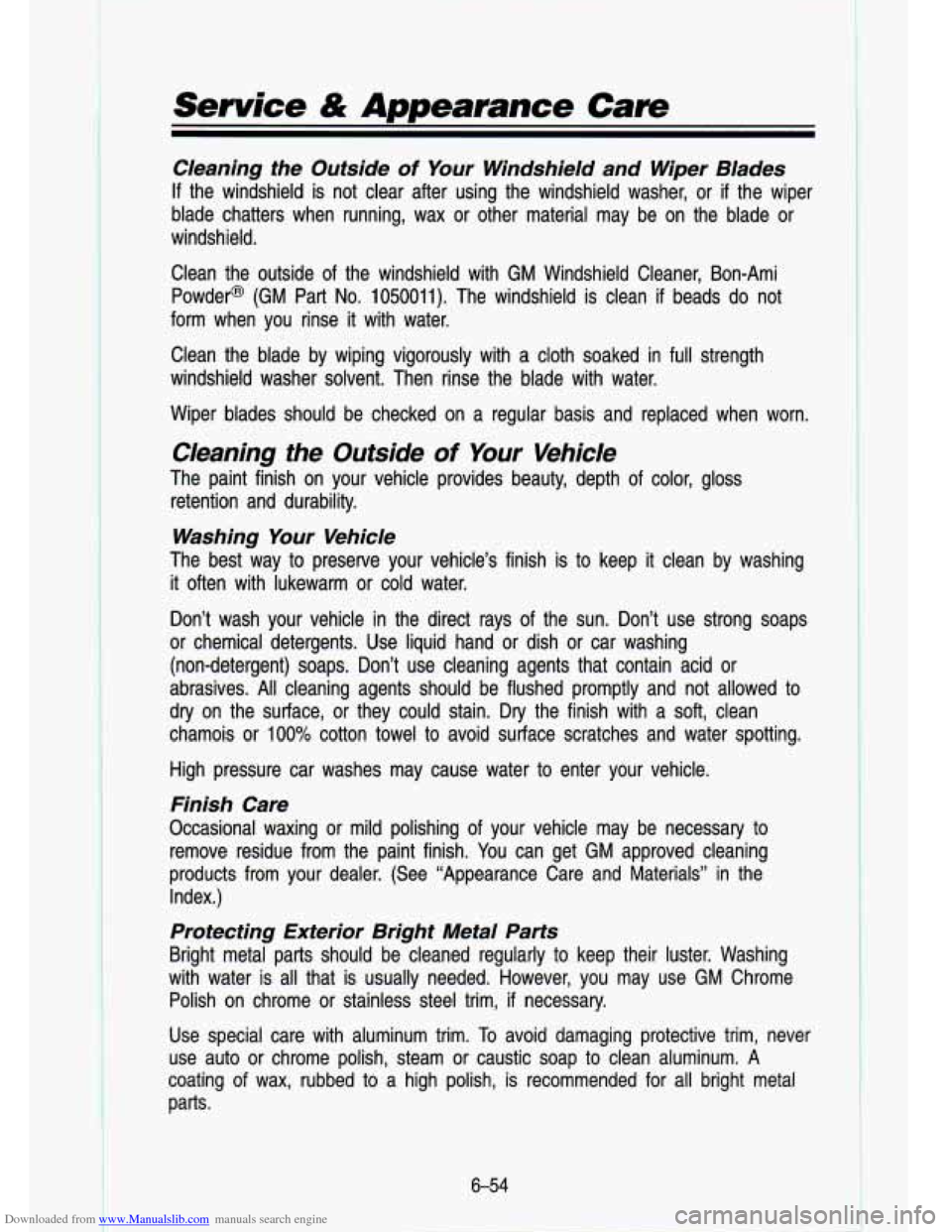
Downloaded from www.Manualslib.com manuals search engine Service & Appearance Cave
Cleaning the Outside of Your Windshield and Wiper Blades
If the windshield is not clear after using the windshield washer, or if the wiper
blade chatters when running, wax or other material may be on the blade or
windshield.
Clean the outside of the windshield with GM Windshield Cleaner, Bon-Ami
Powder@ (GM Part
No. 1050011). The windshield is clean if beads do not
form when you rinse it with water.
Clean the blade by wiping vigorously with a cloth soaked in full strength
windshield washer solvent. Then rinse the blade with water.
Wiper blades should be checked on a regular basis and replaced\
when worn.
Cleaning the Outside of Your Vehicle
The paint finish on your vehicle provides beauty, depth of color, gloss
retention and durability.
Washing Your Vehicle
The best way to preserve your vehicle’s finish is to keep it clean by washing
it often with lukewarm or cold water.
Don’t wash your vehicle in the direct rays of the sun. Don’t use strong soaps
or chemical detergents. Use liquid hand or dish or car washing\
(non-detergent) soaps. Don’t use cleaning agents that contai\
n acid or
abrasives. All cleaning agents should be flushed promptly and n\
ot allowed
to
dry on the surface, or they could stain. Dry the finish with \
a soft, clean
chamois or
100% cotton towel to avoid surface scratches and water spotting.
High pressure car washes may cause water
to enter your vehicle.
Finish Care
Occasional waxing or mild polishing of your vehicle may be necessary to
remove residue from the paint finish. You can get GM approved \
cleaning
products from your dealer. (See “Appearance Care and Materia\
ls’’ in the Index.)
Protecting Exterior Bright Metal Parts
Bright metal parts should be cleaned regularly to keep their luster. Washing
with water is all that is usually needed. However, you may us\
e GM Chrome
Polish on chrome or stainless steel trim,
if necessary.
Use special care with aluminum trim.
To avoid damaging protective trim, never
use auto or chrome polish, steam or caustic soap to clean aluminum.
A
coating of wax, rubbed to a high polish, is recommended for all bright metal
parts.
6-54
Page 304 of 356
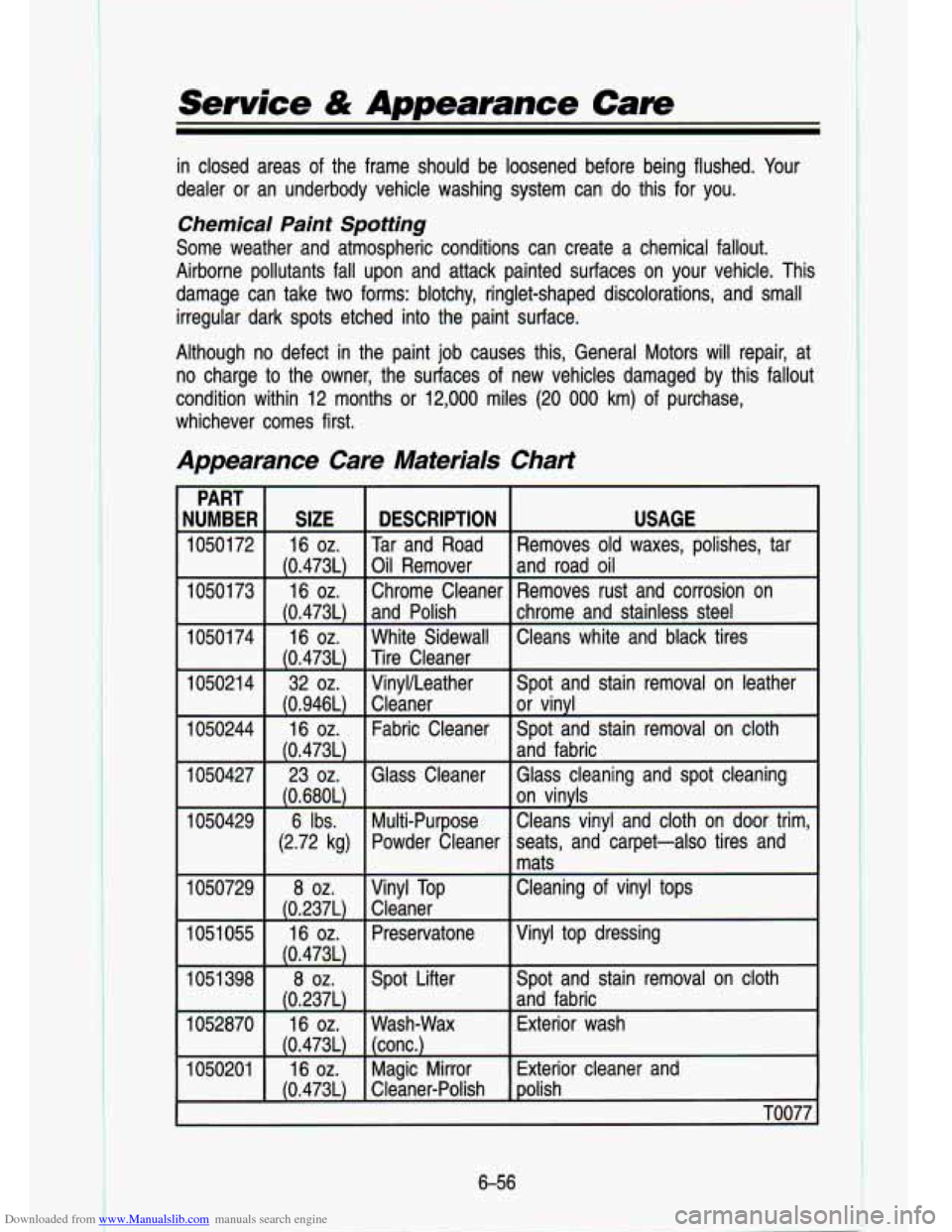
Downloaded from www.Manualslib.com manuals search engine Service & Appearance Care
in closed areas of the frame should be loosened before being flushed. Your
dealer or an underbody vehicle washing system can
do this for you.
Chemical Paint Spotting
Some weather and atmospheric conditions can create a chemical f\
allout.
Airborne pollutants fall upon and attack painted surfaces on your vehicle. This
damage can take two forms: blotchy, ringlet-shaped discolorations\
, and small irregular dark spots etched into the paint surface.
Although no defect in the paint job causes this, General Motors will repair, at
no charge
to the owner, the surfaces of new vehicles damaged by this fallout
condition within 12 months or 12,000 miles (20
000 km) of purchase,
whichever comes first.
Appearance Care Materials Chart
PART
NUMBER SIZE DESCRIPTION
1050172 16
oz. Tar and Road
(0.473L) Oil
Remover
1050173 16
oz. Chrome Cleaner
(0.473L) and Polish
1050174 16
oz. White Sidewall
(0.473L) Tire Cleaner
1050214 32
oz. VinyVLeather
(0.946L) Cleaner
1050244 16
oz. Fabric Cleaner
(0.473L) USAGE
Removes
old waxes, polishes, tar
and road oil
~~ ~~
Removes rust and corrosion on
chrome and stainless steel
Cleans white and black tires
Spot and stain removal on leather
or vinvl
Spot and stain removal on cloth
and fabric
1050427 23
oz. Glass Cleaner Glass cleaning and spot cleaning
(0.680L) on vinyls
1050429
6 Ibs.
(2.72 kg)
1050729 8
oz.
(0.237L)
1051055 16 oz.
(0.473L)
1051398 8
oz.
(0.237L)
1052870 16
oz.
(0.473L)
1050201 16
oz.
(0.473L) Multi-Purpose
Powder Cleaner
Vinyl Top
Cleaner
Preservatone
Spot Lifter
Wash-Wax (conc.)
Magic Mirror
Cleaner-Polish Cleans vinyl and cloth on door trim,
seats, and carpet-also tires and
mats
Cleaning of vinyl tops
Vinyl top dressing Spot and stain removal on cloth
and fabric
Exterior wash
~~
Exterior cleaner and
polish
~nn77
6-56
Page 305 of 356
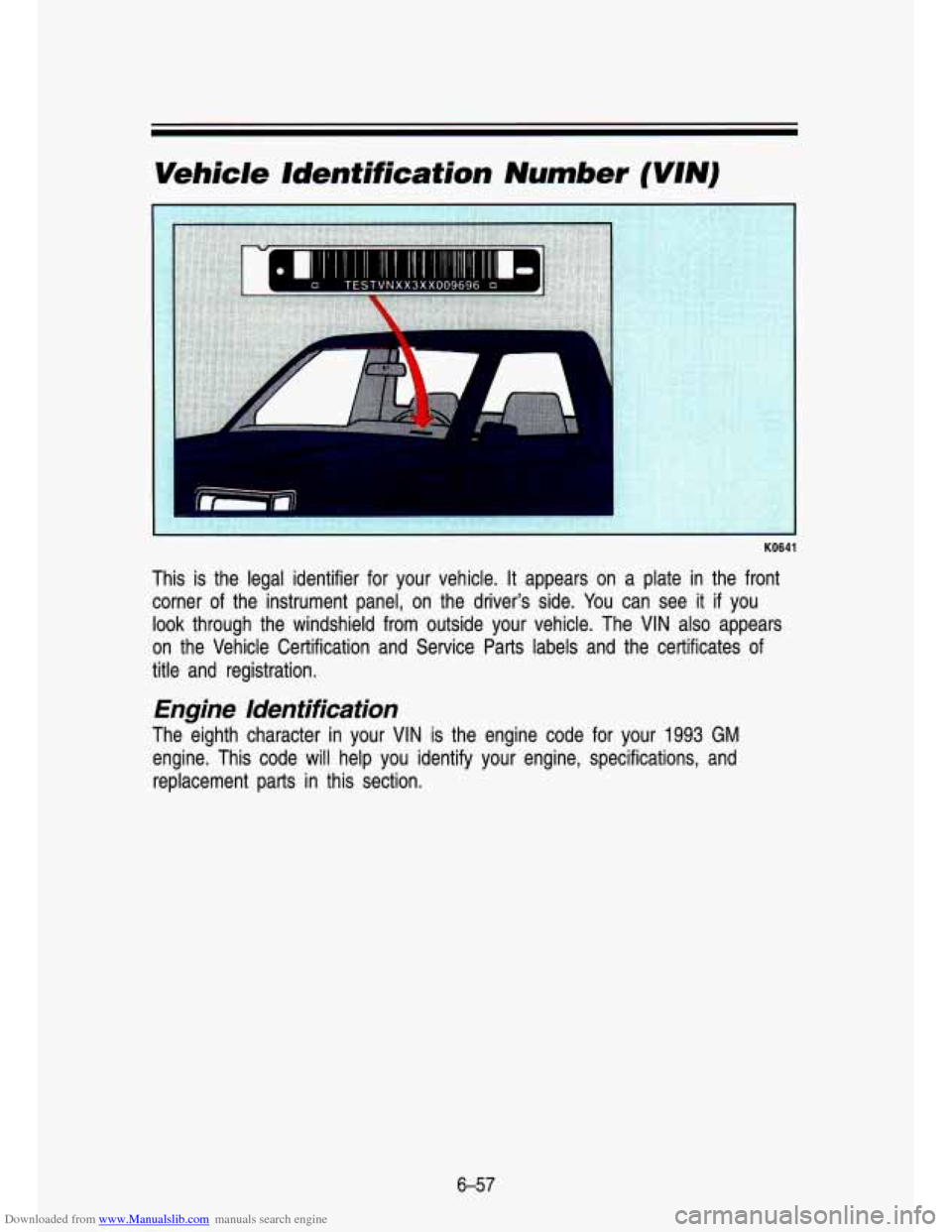
Downloaded from www.Manualslib.com manuals search engine Vehicle Identification Number (VIN)
KO641
This is the legal identifier for your vehicle. It appears on a plate in the front
corner of the instrument panel, on the driver's side. You can see it
if you
look through the windshield from outside your vehicle. The VIN also \
appears
on the Vehicle Certification and Service Parts labels and the \
certificates of
title and registration.
Engine ldenfification
The eighth character in your VIN is the engine code for your 1993 GM
engine. This code will help you identify your engine, specifica\
tions, and
replacement parts in this section.
6-57
Page 306 of 356
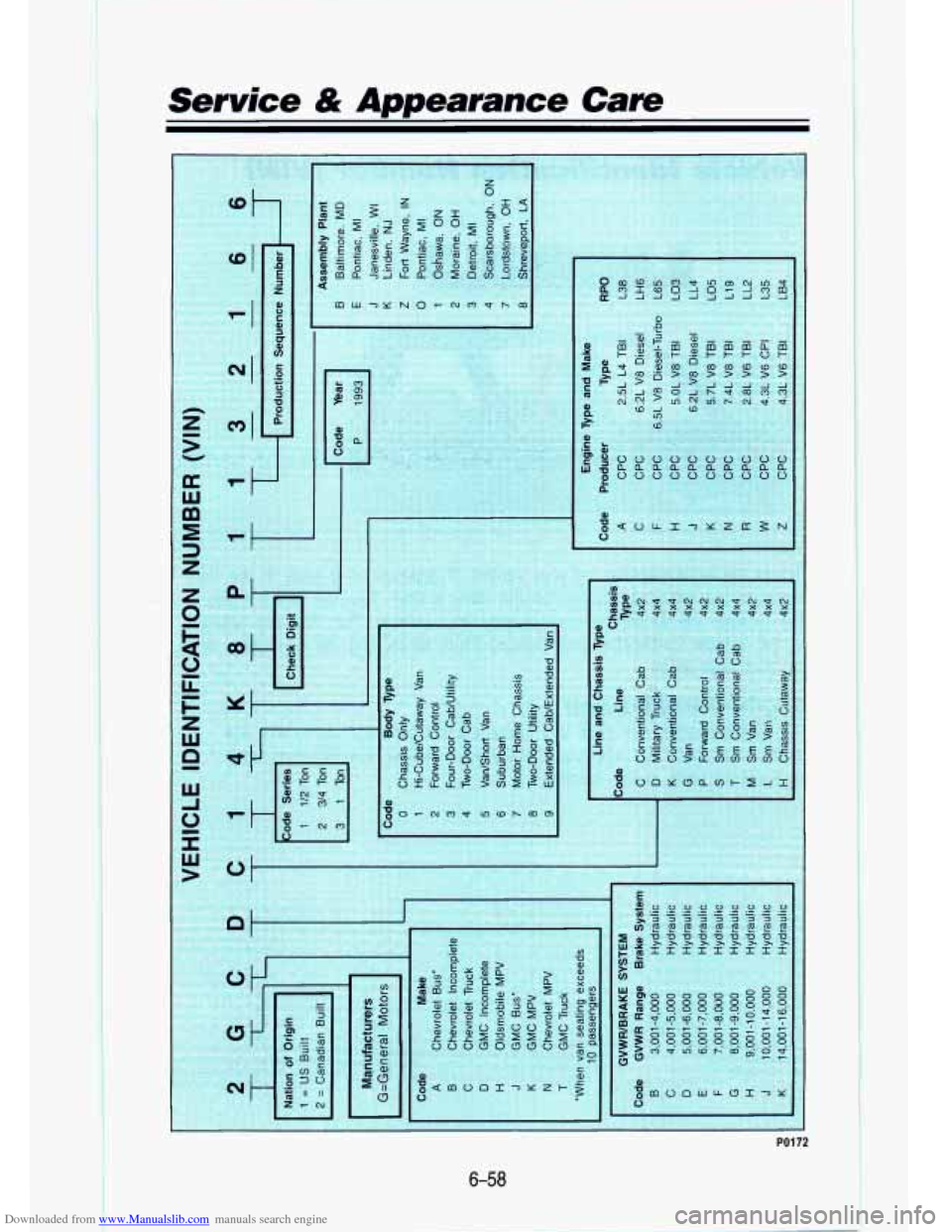
Downloaded from www.Manualslib.com manuals search engine Service & Appearance Care
N
L
a
m
W
z
I2
I
1
I:
W
>
.
1
.. .
PO172
6-58